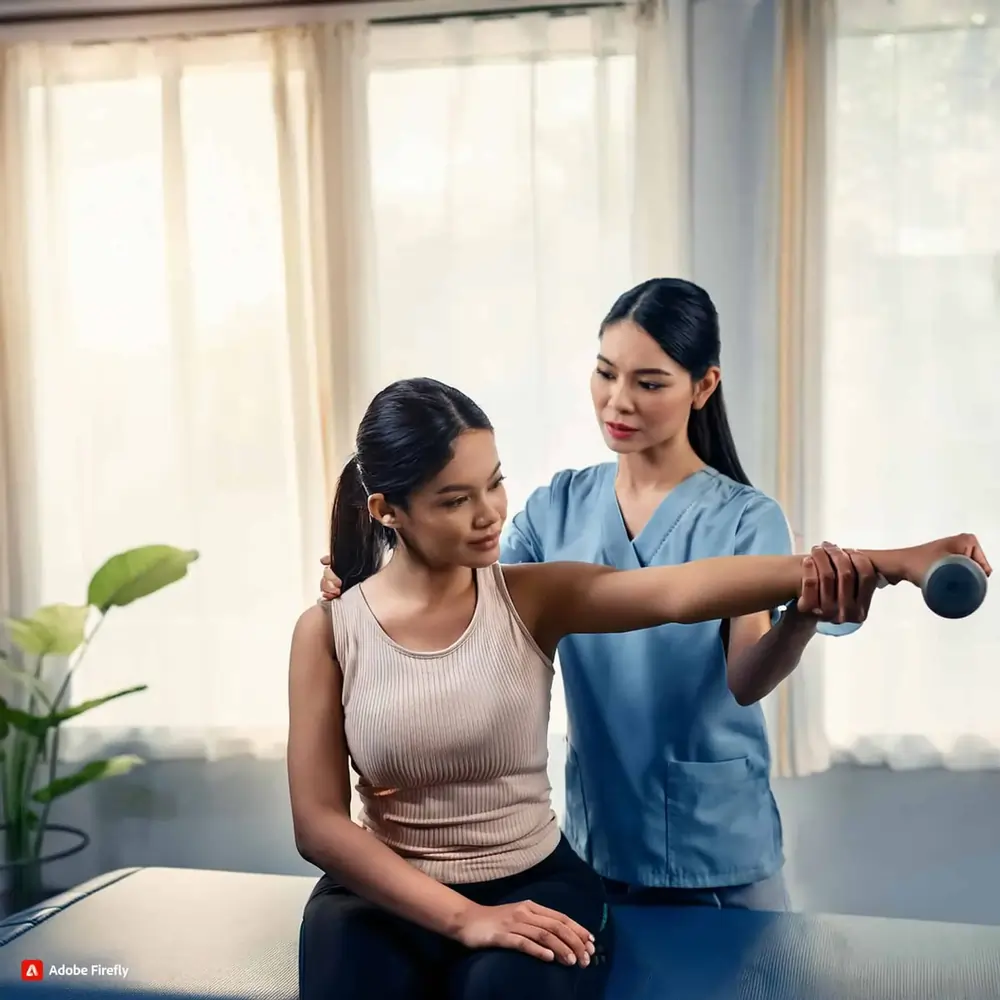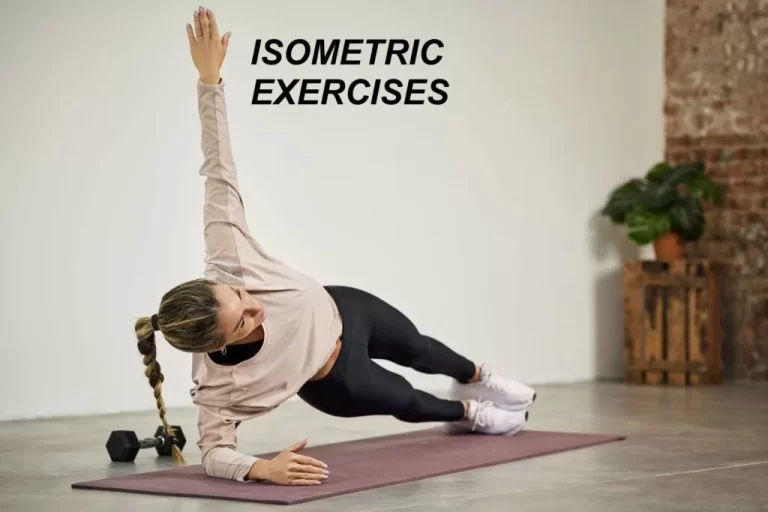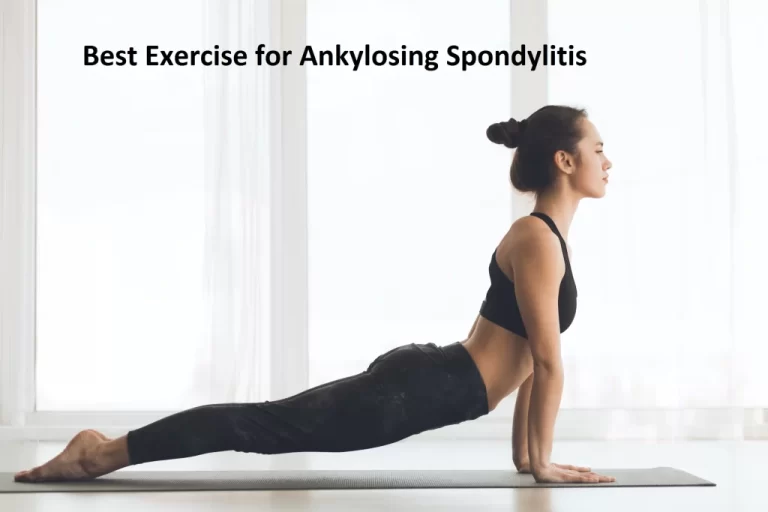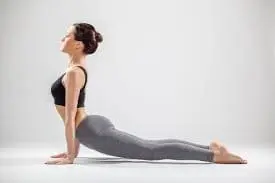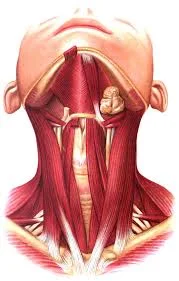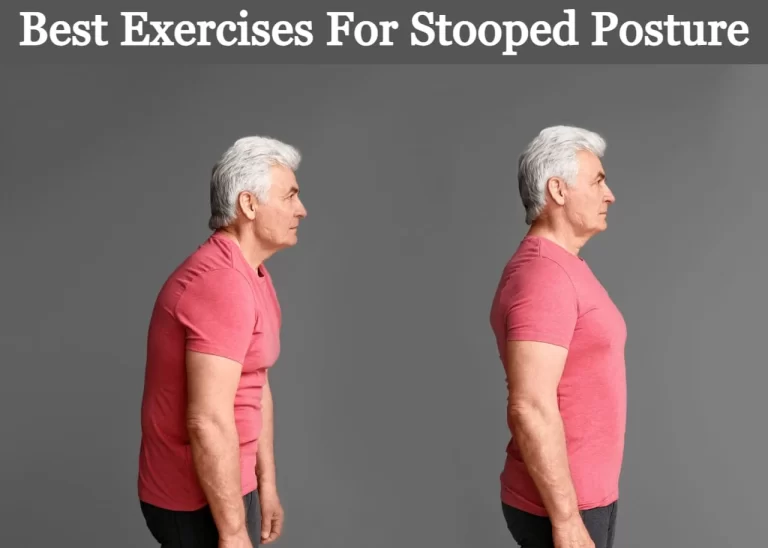14 Best Exercises for Adults With Erb’s Palsy
Introduction:
Erb’s palsy, also known as brachial plexus injury, is commonly associated with birth trauma. Erb’s palsy in adulthood, however, can also result from severe events like motorbike or auto accidents, sports injuries, falls, or surgical problems. The condition comes on by damage to the brachial plexus’s higher nerves, which mostly affects hand, arm, and shoulder sensation and movement.
Erb’s palsy rehabilitation is a progressive process, and Exercises for Adults With Erb’s Palsy must be customised to the individual’s age, degree of damage, and current function. In addition to helping the injured limb regain movement, another goal is to ensure it becomes an integral and practical part of everyday activities.
The affected arm’s strength, range of motion, and flexibility can all be improved with physical therapy and targeted exercises. Additionally, exercises can help avoid the development of muscular imbalances and lessen pain. Other treatments, such as surgery, can also be required in certain situations.
Start out slowly and keep an eye out for any indications of pain or uncomfortable sensations. Short daily workouts are more successful than irregular, lengthy ones, so consistency is essential.
What Causes Erb’s Palsy in Adults?
Trauma that affects the upper brachial plexus nerves, mainly the C5 and C6 nerve roots, which regulate movement and sensation in the upper arm, is usually the cause of Erb’s palsy in adulthood.
Accidents or Trauma
- Accidents involving motor vehicles (such as motorcycles)
- Falls, particularly onto the head or shoulder
- Sports injuries are frequent in contact sports, including rugby, football, and wrestling.
- Trauma caused by violence (such as assault)
Complications from Surgery
- Damage resulting from neck, shoulder, or spine surgery
- During surgery, improper placement caused the brachial plexus to be overly stretched.
Dislocation or Fractures of the Shoulders
- For example, a dislocation of the front shoulder may cause the brachial plexus to be torn or strained.
- Nerves may be affected or severed by clavicle fractures (collarbone).
- Frequent trauma or high-impact falls.
Injury to the Brachial Plexus During Pregnancy That Continues Into Adulthood
- Due to birth trauma that was never properly treated or recovered from, some individuals suffer Erb’s palsy.
- As people age or experience new trauma, their symptoms may increase.
Signs and symptoms:
The degree of nerve regeneration, the severity of the initial damage, and any compensatory or adaptive changes that have taken place over time can all have a significant impact on the symptoms that adults experience.
Weakness in the Affected Arm
- Reduced arm strength to lift, push, or pull.
- Having trouble doing things that need muscle, such as carrying groceries or opening bottles.
Muscle Atrophy (Wasting)
- Significant weakening or loss of the forearm, upper arm, or shoulder muscles.
Arm or Shoulder Pain
- Shoulder, neck, or upper arm pain that is persistent
- In certain situations, nerve pain or burning sensations
- Overuse of the unaffected side as a compensatory mechanism causes pain.
Restricted Motion Range
- Not being able to raise the arm overhead completely.
- Supination, or turning the palm upward, or shoulder rotation, can be challenging.
- Long-term inactivity-related stiffness or tight joints.
Feeling tired in the Affected Limb
- Arm fatigue occurs quickly.
- Strain or pain when performing repetitive motion-intensive jobs
Unusual Feelings of Numbness
- Though not usually present, it may happen when there is damage to the sensory nerves.
Maintaining a Typical Arm Position (Erb’s Palsy Posture)
- You can easily extend the affected arm to the side.
- It’s possible for the forearm to be pronated, or palm facing back.
Limitations in Function
- Difficulty carrying out activities of daily living ( such as getting dressed, grooming, or handling objects
- Using assistive gadgets or modifying one’s motions
Exercise’s advantages:
There are numerous benefits to exercising as an adult with Erb’s palsy, not only in terms of physical health but also in terms of emotional and functional benefits. Exercise should be approached with caution, but a well-thought-out program may greatly improve quality of life.
Increased Endurance and Muscle Strength
- Keeps unused muscle from weakening.
- Increases stamina for routine activities, including carrying, dressing, and lifting.
Improved Coordination and Motor Control
- Improves neuromuscular training, which retrains the brain and body to cooperate more effectively.
- Gradually creates actions that are more fluid and well-coordinated.
Pain Reduction
- Mild movement can improve blood flow, reduce inflammation, and ease chronic pain.
- When stabilizing muscles are strong, joints and nerves experience less stress.
Improved Balance and Posture
- Avoids or fixes bad posture, which frequently arises when the stronger side makes up for the weaker side.
- Helps stabilise the shoulder girdle, which lessens strain and long-term imbalance.
Better Performance in Everyday Tasks
- Increases the capacity to perform everyday duties (such as dressing, cooking, and grooming) on one’s own.
- Lessens dependency on others and encourages functional independence.
Increased Flexibility and Mobility of the Joints
- Range of motion in the wrist, elbow, and shoulder can be maintained or increased with exercise.
- Avoids contractures (permanent shortening of muscles or tendons) and lessens joint stiffness.
Make sure you take the following safety measures before starting an exercise program:
Before beginning any fitness program, it’s crucial to think about a few safety precautions to safeguard your health and improve its benefits.
Exercise-related soreness is common, but if it worsens, it may be a sign that you’re pushing yourself too much. Once you can tolerate more difficulty, progress from low-impact exercises to hard ones.
Consult a recognised expert for guidance if you are unsure about how to dedicate yourself to a fitness routine. Make sure your muscles and joints are prepared for the activity by warming them up before starting.
Exercises For Erb’s Palsy:
Shoulder Flexion
- Get started by standing on the ground.
- Next, use both arms to hold a wand.
- On both sides, palm down.
- Raising the wand will allow your unaffected arm to undertake the majority of the job.
- You should slightly relax the arm that is affected.
- Hold this position for a few seconds.
- Then return to your neutral position.
- Then relax.
- Repeat these exercises 5 to 10 times.
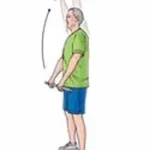
Shoulder abduction and adduction
- Begin by standing on the ground.
- Hold a wand with both arms after that.
- Maintain a palm-out position.
- Let the stick settle over your thighs.
- While keeping your elbows straight, push the opposite arm as high and out to the side as you can with the first arm.
- Then return to your neutral position.
- Then relax.
- Repeat these exercises 5 to 10 times.
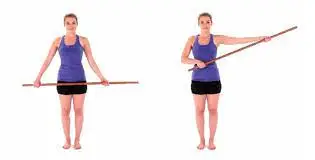
Shoulder Circles
- First, take a position on the ground.
- Then continue to spread your arms wide.
- Use your arms in a circular motion while maintaining a straight elbow.
- Your level of comfort determines the circle’s size.
- Then return to your neutral position.
- Then relax.
- Repeat these exercises 5 to 10 times.

Elbow flexion
- Look for a spot where you can stand comfortably.
- Take a deep breath.
- Lift your arm and bend it slowly.
- Hold this position for a few seconds.
- Move your arm down.
- Then return to your neutral position.
- Then relax.
- Repeat these exercises 5 to 10 times.
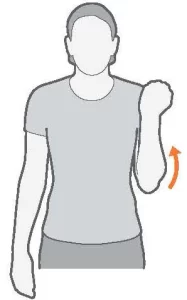
Pendulum Swings
- Breathe deeply for a few moments while standing upright on the ground.
- With one hand resting on a table or counter for balance, bend forward.
- Gently swing your arm back and forth.
- Continue the exercise by moving your arm from side to side and then circularly.
- Then return to your neutral position.
- Then relax.
- Repeat these exercises 5 to 10 times.
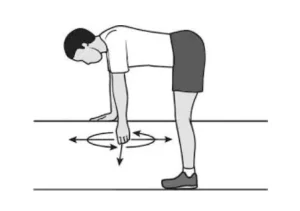
Finger ladder
- A person stands facing a ladder that hangs over a wall.
- Encourage them to carefully rest their affected hands on the ladder’s low step.
- After that, start slowly and work your way up to the top of the finger ladder before slowly going down to the bottom.
- Then return to your neutral position.
- Then relax.
- Repeat these exercises 5 to 10 times.

Resistance External Rotation
- Start with the standing position.
- One end of a band is folded in half horizontally and held in each hand with the palms facing up in an underhand grip.
- Your arms should be close to your sides after you have bent your elbows till your forearms are parallel to the floor.
- To get your chest straight, gently move your shoulder blades back and down.
- Inhale.
- The tension in the band may be increased by pulling your forearms outward while trying to maintain as stable a shoulder position as possible.
- The area between your shoulder blades and behind your shoulders should feel somewhat compressed.
- Hold this posture for a few seconds.
- Then return to your neutral position.
- Then relax.
- Repeat these exercises 5 to 10 times.
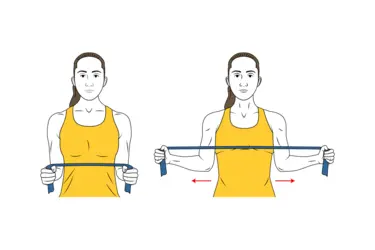
Resistance Internal Rotation
- Standing comfortably on the ground is the very first step.
- A significant resistance or elastic band can be fastened to a doorknob.
- Using one hand, grasp the opposite end of the band.
- Maintaining the forearm close to the body, bend the arm at the elbow.
- Hold this position for a few seconds.
- Then return to your neutral position.
- Then relax.
- Repeat these exercises 5 to 10 times.
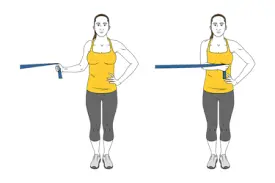
Dumbbells Lateral Raises
- To begin, choose an upright position on the ground.
- With a pair of light dumbbells in your hands, place your feet slightly wider than hip-width apart.
- Push the weights to the sides until they reach shoulder height.
- Remember to activate your core.
- Hold this position for a few seconds.
- Slowly lower the weights to the sides.
- Then return to your neutral position.
- Then relax.
- Repeat these exercises 5 to 10 times.
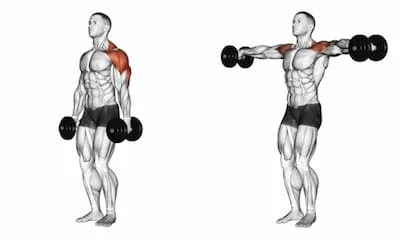
Bicep Curls
- Step your feet hip-width apart and begin to stand straight up.
- Make sure your abdominal muscles are engaged.
- Next, hold dumbbells.
- Your arms should be at your sides with your palms facing front.
- Maintain a calm posture and stable upper arms.
- Raising the weights until the dumbbells are close to your shoulders requires bending at the elbow.
- Your elbows should remain close to your upper body.
- While raising, release your breath.
- Lower your dumbbells.
- Then return to your neutral position.
- Then relax.
- Repeat these exercises 5 to 10 times.
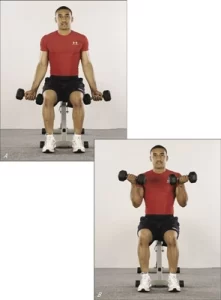
Triceps Kickbacks
- To prepare for the dumbbell triceps kickback, take a flat bench and place a dumbbell at one end of it on the left.
- Position yourself on the left side of the bench, placing your right knee and right hand on it.
- Hold the dumbbell in a neutral grip with your left hand.
- Remain upright and concentrate on the present.
- Bend at the elbow and tuck your left upper arm close to your chest to form a 90-degree angle with your forearm and upper arm.
- This is the initial position.
- Raising the dumbbell behind you until your arm is completely extended requires simply elbow movement.
- Then return to your neutral position.
- Then relax.
- Repeat these exercises 5 to 10 times.
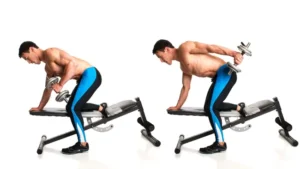
Cross-body shoulder stretch
- To begin, stand up straight.
- Put one arm over your chest.
- Hold the arm across your body by its outer forearm with your other hand.
- Push that arm into your body for further stretch.
- Hold this position for a few seconds.
- Then return to your neutral position.
- Then relax.
- Repeat these exercises 5 to 10 times.
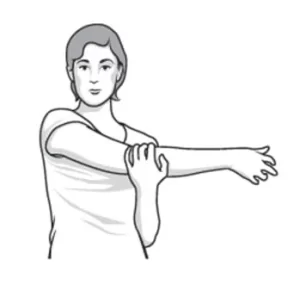
Wall push-up
- Place your feet several feet from a wall.
- Arms and legs straight, lean forward, and place your hands on the wall at chest height.
- You should be able to support some of your weight with your arms.
- Lower your chest towards the wall and slowly bend your elbows.
- Stop when your head and torso are nearly touching the wall.
- Then return to your neutral position.
- Then relax.
- Repeat these exercises 5 to 10 times.
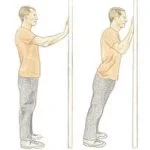
Towel Slides
- Lay a towel across the table.
- Put the weaker arm over the towel.
- Extend your arm out in front of you using your elbow and shoulder strength.
- As much as you can, keep your arm straight.
- Bend your elbow with the strength of your weaker arm.
- Pull your arm back towards you.
- Then return to your neutral position.
- Then relax.
- Repeat these exercises 5 to 10 times.

What safety measures ought to be taken when exercising?
A medical clearance is required first.
- Consult a physician earlier than beginning a new workout plan.
- Check for contraindications.
Thoroughly warm up and cool down.
- Mild warm-ups stimulate the muscles and nerves and improve circulation.
- Cooling down helps control inflammation and avoid stiffness.
Keep an eye out for warning indicators.
- Exercise should be stopped right away if you encounter:
- Fatigue following an exercise that persists for hours or days
Put a focus on position and proper posture.
- During activity, imbalance can put stress on the nerves and the corrective muscles.
- Place a particular focus on shoulder position, neutral spine, and scapular stability.
- For posture correction, use mirrors or a trainer’s comments.
Start by moving with controlled motions and little resistance.
- Do not use jerky actions or force.
- Use resistance bands, lighter dumbbells, or bodyweight workouts as your starting point.
- Develop neuromuscular control and endurance before stepping up to the next level.
When necessary, use supportive equipment.
- During exercise, weak joints may be stabilised by kinesiology tape, braces, or straps.
- Training can be safer and more effective with the use of customised exercise equipment, such as hand grips and adjusted weights.
Avoid Tiredness in the Affected Limb
- Muscle fatigue raises the possibility of nerve tension, unstable joints, and poor form.
- Rest between sets and limit the number of repetitions.
- Think about doing interval training with lots of breaks.
Include Nerve Glides and Gentle Stretching
- Keep the brachial plexus from being overstretched and preserve joint mobility.
- To keep the nerve pathway flexible and lessen connections, perform the nerve gliding exercises that a therapist has taught you.
Put functional goals ahead of aesthetic ones.
- Better everyday living, not bigger muscles or weightlifting records, is the aim.
- Prioritise improving joint integrity, strength, balance, coordination, and range of motion.
When did you stop working out?
Sharp or Unexpected Pain
- Particularly in the upper arm, neck, or shoulder.
Muscle Weakness That Interrupts Growth
- The risk of injury increases when you cannot maintain proper balance or posture.
- Doing fewer repetitions correctly is preferable to pushing through with bad form.
Loss of Grip or Strength
- Stop immediately if the affected arm starts to feel weak, unstable, or uncoordinated.
- Ignoring this can make nerve dysfunction worse.
Burning, tingling, or numbness
- These indicate overstimulation or nerve compression.
- Stop right away and take a nap.
- Speak with a healthcare professional if it continues.
Using Other Body Parts to Make Up for It
- Secondary pain or injury (such as spinal strain or shoulder impingement) may result from this.
Breathlessness or feeling lightheaded
- Keep an eye out for dizziness, particularly when performing upper-body exercises.
- It can be the result of poor breathing technique or excessive exercise.
When you have Erb’s palsy, which workouts should you avoid?
Adults with Erb’s palsy need to stay clear of activities that may worsen symptoms, injure them, or put excessive stress on other body parts.
Shoulder presses or raising weights overhead
- Strong shoulder and deltoid stabilisation is necessary for this, and Erb’s palsy frequently affects them.
- Risks include nerve compression, shoulder dislocation, and a worsening of muscular imbalance.
Heavy Lifting (With the Affected Arm in Particular)
- The neck or spine may become injured or compensate if weak muscles or joints are subjected to excessive tension.
- Risks include worsening pain, dislocated joints, or more irritation of the nerves.
Suspension training or unsupported arm hanging.
- Pull-up bars and other bodyweight hanging exercises increase brachial plexus tension.
- Examples include TRX movements without shoulder support and dead hangs.
Contact or High-Impact Sports
- The possibility of harm to the affected arm or shoulder.
Summary:
The brachial plexus nerves, a network of nerves close to the neck that regulate the muscles of the shoulder, arm, and hand, can get damaged and result in Erb’s palsy. Although injuries or accidents later in life can sometimes cause this damage, it usually happens during childbirth when the baby’s neck is strained during delivery.
The degree of Erb’s palsy in adulthood might vary. In their affected arm, some people may suffer from muscle atrophy, chronic pain, or restricted movement. Rehabilitation concentrates on making the most of current muscle and nerve function while avoiding stiffness or further loss of movement because nerves do not quickly regenerate.
The primary goal of treatment for Erb’s palsy is to restore arm function, and techniques such as physical therapy have been employed to increase muscle strength and joint mobility. While minor nerve injury may resolve on its own without help, some cases require surgery or other therapy.
Many individuals require ongoing physical therapy and rehabilitation, even if some recover on their own. Strengthening, function restoration, and injury reduction all depend on exercise.
Even though the severity can vary, physical treatment and consistent exercise are essential to improve the affected arm’s strength, range of motion, and functionality.
You can reduce pain and enhance your general health by including these exercises in your routine, along with proper posture and movement awareness. Always get advice from a physical therapist before beginning a new exercise program, especially if you have a particular injury or condition.
FAQ:
Which activities are most effective to improve arm function following a brachial plexus injury?
Stretching, strengthening (with resistance like weights or bands), passive range of motion, and daily chores like dressing or grooming are all components of the greatest exercises. Over time, these increase strength, control, and mobility.
How often should I perform exercises to treat injury to my brachial plexus?
It is best to practise every day, particularly for mobility exercises and mild stretches. Depending on the severity, your therapist can suggest two to three concentrated sessions every day.
Does exercise have the ability to alleviate brachial nerve pain?
In fact, by enhancing circulation, decreasing muscular tension, and promoting general function, guided workouts may help in the relief of nerve-related pain. To prevent overdoing it, always get advice from a therapist.
Which brachial plexus treatment is the most effective?
In most cases, non-surgical treatments, including therapy and rehabilitation, are effective. Surgery is only an option for serious injuries that cannot be healed naturally.
Is damage to the brachial plexus permanent?
Not all the time. Early and regular therapy helps many individuals recover completely or in part. The severity and nerves involved affect recovery.
Can exercise help adults with Erb’s palsy?
Yes. With the possibility of chronic nerve injury, exercise can help:
Strength of muscles in unaffected areas
Range of motion
Joint stability and posture
General performance and pain control
Which kinds of exercises are advised?
Stretching: To keep your body flexible and avoid contractures
Exercises for the range of motion: To maintain the mobility of joints
Strength training: To make up for lost muscle mass
Training for posture: To avoid pain and imbalance
Tasks for occupational therapy: To improve everyday functioning
Is it possible for exercise to improve nerve function?
Nerve damage cannot be repaired by exercise; however, it makes the most of the available muscle function. Avoids future problems and can encourage other muscles to undergo adaptive changes.
When exercising, may assistive devices be helpful?
Yes. Exercise security and performance can be increased with the use of equipment like resistance bands, wrist supports, or adjustable grips.
Is pain typical when working out?
No. Sharp or radiating pain is an indication a stop, although slight pain or fatigue is acceptable.
References:
- Null, n.d. A CB rehabilitation. CbPhysiotherapy. https://cbphysiotherapy.in/exercise/top-5-exercises-for-erb-s-palsy
- Plexus. June 18, 2025. Plexus. PLEXUS. https://plexusnc.com/brachial-plexus-injury-workouts/ The best exercises for brachial plexus injuries
- S. C. B. Surgery & S. (2025, June 12). Southern California Brain & Spine: 5 Arm Exercises to Help With Brachial Plexus Injuries. Spine and Brain Surgery in Southern California. Exercises to enhance arm function following a brachial plexus injury: https://socalbrainspine.com/5-exercises-to-improve-arm-function/
- Mya Care, n.d. ERB’S PALSY: INJURY TO THE BRACHIAL PLEXUS NERVE IN ADULTS AND NEWBIRNS | MyA Care. Erbs-palsy-brachial-plexus-nerve-injury in newborns and adults: https://myacare.com/blog/
- The causes, diagnosis, and management of ERB’s palsy (n.d.) Baptist Health. Health Baptist. Erbs-palsy https://www.baptisthealth.com/care-services/conditions-treatments
- Image 12, Warner, J. (June 30, 2020). Coach, this is how you execute the triceps kick-back. triceps-exercises/6913/how-to-do-the-triceps-kick-back https://www.coachweb.com
- Image 15, T. F. D. P., Therapist (2024, April 19). Physical Therapy Education Resources for All | PTProgress. Exercises for Rotator Cuff Surgery: https://www.ptprogress.com/

